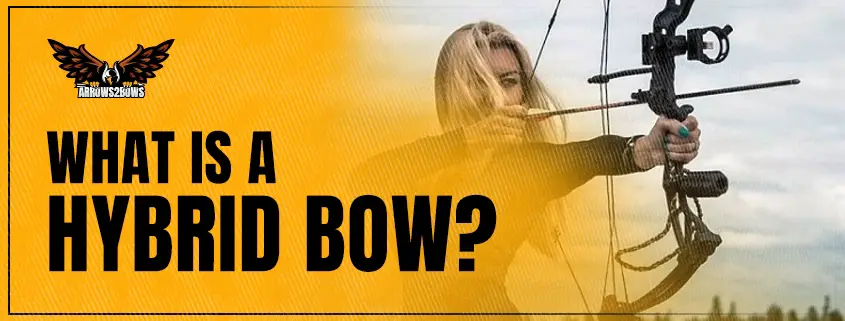What is a Hybrid Bow?
Humans have been honing their archery skills for thousands of years. Since our distant ancestors first strung sinew on wood to launch pointy sticks at small animals, people have also been trying to hone archery technology.
Bows have certainly progressed since those early crude attempts. Although still considered “primitive” weapons, some modern bows and arrows (and the accessories that go with them) are pretty high tech.
In a constant and persistent urge to design the perfect bow, some companies try to combine the best aspects of two different types of archery technology. Sometimes when this happens, something totally new (and highly useful) comes out of the effort. One such result is the hybrid bow.
What Makes it a Hybrid?
Merriam Webster defines the word “hybrid” this way:
Hybrid (adjective) – having or produced by a combination of two or more distinct elements.
In archery, a hybrid bow is one that combines elements from two separate types of bows. Usually a hybrid bow has a sort of crossbred limb design which blends the power of a recurve bow with the forgiveness of a longbow.
Longbows
Longbows are the icons of the archery world. The earliest known example of a longbow was made from yew and dated to around 3,300 BC. These bows roughly resemble an elongated letter “D.”
The longbow is sometimes called the “Medieval machine gun,” due to its use during the Hundred Years’ War. English archers could reportedly fire 10 to 12 arrows per minute. When done en masse, peasant archers could make the sky rain arrows on mounted French noblemen.
Because a longbow is (you guessed it) long, it tends to be more forgiving than the shorter recurve bow. Some longbows are as long as their shooters are tall. That length makes them more stable to shoot and prevents torqueing (or twisting) of the bow. The stability makes them more forgiving of inconsistencies in shooting form and makes them naturally more accurate.
The height of a longbow also makes them easier to shoot (especially for beginners). This is because the bow weight is dispersed over a larger area, creating a smoother draw and providing some versatility in draw length.
The downside to their size is that the length makes them difficult to transport and even harder to maneuver in the woods or from the close quarters of a hunting blind.
Longbows are also less powerful than most recurves. This makes them less suited for both hunting and long-distance shooting. A powerful bow is important for long distance shooting because an arrow needs energy to travel long distances.
In bowhunting, power is necessary to push the arrow through an animal’s hide and through soft tissue to reach vital organs.
Another drawback to the traditional longbow is that they tend to produce significant hand shock. This can be quite uncomfortable for the archer and can have a negative impact on shooting accuracy.
Recurve Bows
A recurve bow was originally an improvement on the longbow design. The ancient Mongolians are credited with the invention, and they took advantage of the recurve’s shorter size to wage war from horseback.
When a recurve bow is unstrung, the limbs curve away from the archer. When strung, the bow curves back toward the archer, and the re-curves back toward the front of the bow. Its shape roughly resembles the number 3.
That signature recurved limb design stores energy and releases it more efficiently than the limbs on the traditional longbow design. This extra energy transfers to the arrow, resulting in faster speeds, longer distances, and deeper target penetration.
While that extra energy makes the recurve more effective for both hunting and war, shooting a recurve bow accurately requires a great deal of practice. It can take years to develop any sort of proficiency with a recurve bow.
Recurve bows also tend to be noisy shooters. Generating significant noise upon arrow release can be a major drawback for bowhunters or archers relying on stealth.
The Reflex/Deflex Design – The Best of Both Worlds
A hybrid bow is an attempt to smash the design of the longbow and recurve together, preserving the best elements of each design while minimizing their deficiencies.
Today’s hybrid bows use a reflex/deflex design. Reflex means the limbs curve away from you. Deflex means they curve toward you. So, does this mean a hybrid bow is a longbow with recurve limbs? Not quite.
Usually a hybrid bow has a deflexed riser and reflexed limbs. It almost looks like a recurve, but the curves are much less aggressive.
Some traditional archers will argue that a hybrid bow is really just a recurve. Others classify hybrid bows as longbows (Some even call them reflex/deflex longbows). The truth is, they are both and neither. A hybrid bow is really in a class by itself.
The reflex/deflex design increases arrow speed and accuracy like a recurve. However, the design also maintains the shootability and forgiveness of a longbow.
It also reduces the uncomfortable hand shock that is common in longbows. And that excessive noise generated by the standard recurve is also diminished by the reflex/deflex shape.
Modern hybrid bows are made with a variety of materials. You can still find a hybrid bow made from natural materials like yew, bamboo, ash, hickory, and oak wood, although sometimes the wood may be laminated.
Although still considered primitive weapons, many hybrid bows aren’t made from traditional wood at all. Instead, you can find hybrid bows made from fiberglass, metal, high-tech carbon composite materials, and even lightweight foam.
What are Hybrid Cams?
Cams are the pulleys or wheels on a modern compound bow and are the main features that distinguish a compound bow from more traditional weapons (like the longbow or recurve bow).
You may hear the word “hybrid” used to reference a specific type of cam system.
A hybrid cam system has two asymmetrical oblong wheels at the top and bottom of the bow. Attached to the top limb is a control cam. A power cam is attached to the bow’s bottom limb. In addition to the bow’s main string, the hybrid system is equipped with a single split harness and a control cable.
Hybrid cam systems require less maintenance than many other cam systems commonly found on compound bows (especially bows with a “twin cam” system). A popular choice for bowhunters, hybrid cam compound bows produce sizzling arrow speeds and minimal noise.
Although some compound bows feature hybrid cams, these bows are not the same thing as a “hybrid bow.”
Summing It Up
If you enjoy the traditional feel of a primitive bow, a hybrid bow may be the perfect option for you. A hybrid bow is more powerful than the classic longbow, making it more suitable for hunting and long-distance shooting. However, a hybrid bow maintains the steady shootability of the historic longbow design. The hybrid really is a combination of the best aspects of both the longbow and the recurve bow.
Although somewhat easier to master than the recurve bow, you’ll still want to spend some time practicing with a hybrid. Whether you plan to shoot whitetails or bullseyes, practice is the only path to proficiency. This is true no matter what style of bow you’re shooting.




